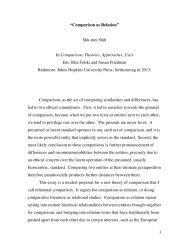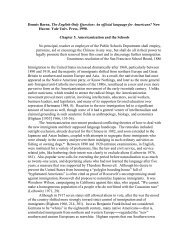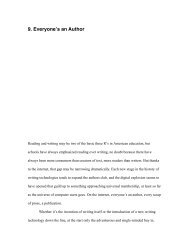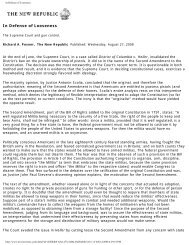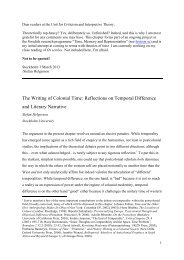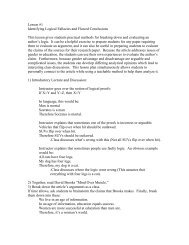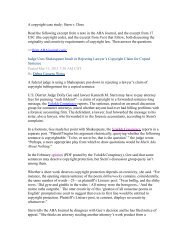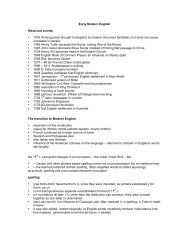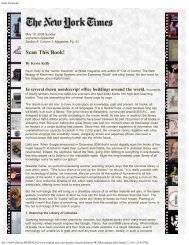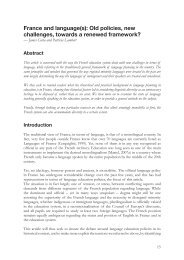Technics of the Subject: The Avatar-Drive Emily Apter - English
Technics of the Subject: The Avatar-Drive Emily Apter - English
Technics of the Subject: The Avatar-Drive Emily Apter - English
You also want an ePaper? Increase the reach of your titles
YUMPU automatically turns print PDFs into web optimized ePapers that Google loves.
Postmodern Culture<br />
Volume 18, Number 2, January 2008<br />
E-ISSN: 1053-1920<br />
DOI: 10.1353/pmc.0.0021<br />
<strong>Technics</strong> <strong>of</strong> <strong>the</strong> <strong>Subject</strong>: <strong>The</strong> <strong>Avatar</strong>-<strong>Drive</strong><br />
<strong>Emily</strong> <strong>Apter</strong><br />
Department <strong>of</strong> French, New York University<br />
emily.apter@nyu.edu<br />
Abstract<br />
This essay considers <strong>the</strong> digital avatar not simply as a name for a virtual double <strong>of</strong> <strong>the</strong> player <strong>of</strong><br />
videogames, but as bound to or manifesting psychological drive, a kind <strong>of</strong> homunculus <strong>of</strong> <strong>the</strong><br />
drive. Drawing on a wide range <strong>of</strong> <strong>the</strong>ories that have informed technical constructions <strong>of</strong> <strong>the</strong><br />
subject, it applies in particular an important moment in Lacan's description <strong>of</strong> <strong>the</strong> drive to <strong>the</strong><br />
concept <strong>of</strong> <strong>the</strong> gaming "avatar." It argues that <strong>the</strong> avatar is a variant <strong>of</strong> precursor representations<br />
<strong>of</strong> <strong>the</strong> drive specific to <strong>the</strong> technical imaginary <strong>of</strong> videogames.<br />
<strong>The</strong> avatar haunts media and cyperspace in multiple guises. Nested in online chat rooms and<br />
seminars, internet commodity arcades, art installations, game worlds, architectural models, datashadows,<br />
and program algorithms, <strong>the</strong> avatar has become <strong>the</strong> face <strong>of</strong> it-ness, who-ness, and whatness<br />
mediating community and unseating <strong>the</strong> subject's Eigentlichkeit (self-possession, <strong>the</strong><br />
"having" <strong>of</strong> what is my own).1 As <strong>the</strong> visible interface <strong>of</strong> <strong>the</strong> psychic drive, <strong>the</strong> avatar is not so<br />
much <strong>the</strong> double <strong>of</strong> <strong>the</strong> subject in <strong>the</strong> digital field as a kind <strong>of</strong> "puppet-homunculus" or totem that<br />
"drives" <strong>the</strong> drives. Freud's notion <strong>of</strong> psychic drive as "constant force" (konstante kraft),<br />
instrumentalized in its goal-directed motricity, becomes newly relevant to <strong>the</strong> object-oriented<br />
worlds <strong>of</strong> games and internet markets in <strong>the</strong>ir subsumption and transformation <strong>of</strong> subjective<br />
properties.2 Like <strong>the</strong> Aristotelian hyle (<strong>the</strong> causative and self-circular property <strong>of</strong> a form),<br />
avatarity, as I develop <strong>the</strong> concept here, bears on post-poststructuralist accounts <strong>of</strong> <strong>the</strong><br />
destinations <strong>of</strong> agency in a technical milieu.<br />
Parade <strong>of</strong> <strong>the</strong> <strong>Subject</strong>s<br />
No <strong>the</strong>ory <strong>of</strong> <strong>the</strong> avatar can be divorced from <strong>the</strong>ories <strong>of</strong> <strong>the</strong> subject. <strong>Subject</strong> <strong>the</strong>ory––buoyed in<br />
successive waves by <strong>the</strong> time-lag <strong>of</strong> French and German translations––predominated in <strong>the</strong><br />
human sciences from <strong>the</strong> postwar period through <strong>the</strong> mid-1990s. Though some argue that it lost<br />
traction in <strong>the</strong> "post-critical" contemporary moment, I contest this idea. <strong>Subject</strong> <strong>the</strong>ory endures as<br />
a "technics <strong>of</strong> <strong>the</strong> subject" situated at <strong>the</strong> juncture <strong>of</strong> philosophy, psychoanalysis, and media<br />
<strong>the</strong>ory, and nourished by subfields as far-flung as systems <strong>the</strong>ory, pragmatism, cybernetics,<br />
chaos <strong>the</strong>ory, Heideggerian and Benjaminian notions <strong>of</strong> techne, Deleuzian vitalism and<br />
projections <strong>of</strong> <strong>the</strong> virtual, symbolic logic, artificial intelligence, computer programming,<br />
pros<strong>the</strong>tics, genomics, posthumanism, and game <strong>the</strong>ory. <strong>The</strong> time-line <strong>of</strong> <strong>the</strong>se disciplinary<br />
interactions is uneven, but not so uneven as to obscure <strong>the</strong> subtle yet generic shift from<br />
poststructuralist accounts <strong>of</strong> subjective impersonalism––from <strong>the</strong> mid-1990s on––to medial<br />
1
<strong>the</strong>ories <strong>of</strong> <strong>the</strong> subject imbued with what French sociologist Georges Friedmann dubs "<strong>the</strong><br />
technical milieu."3 A specialist <strong>of</strong> factory life and subjective submission to <strong>the</strong> technical<br />
environment, Friedmann stands alongside Raymond Ruyer and Gilbert Simondon (especially<br />
important in conceptualizing a hylomorphic understanding <strong>of</strong> <strong>the</strong> human as ontologically utensil,<br />
as well as a somato-psychic <strong>the</strong>ory <strong>of</strong> <strong>the</strong> existence-mode <strong>of</strong> objects) among <strong>the</strong> precursors <strong>of</strong><br />
Deleuze and Guattari who toge<strong>the</strong>r most significantly articulated philosophies <strong>of</strong> machinic<br />
expressionism and virtual ontology.4 As a set <strong>of</strong> thinkers, <strong>the</strong>y join Freud and Lacan––<strong>the</strong><br />
founders <strong>of</strong> analytic technique, and Heidegger, <strong>the</strong> premier <strong>the</strong>orist <strong>of</strong> technè and Bestand<br />
("standing-reserve," by which he refers to nature's latent capacity to be technologically entrained<br />
by man), in setting <strong>the</strong> terms <strong>of</strong> subject technics. <strong>The</strong> work <strong>of</strong> Bernard Stiegler is also especially<br />
germane; his La Technique et le temps 1, La faute d'Epiméthée [<strong>Technics</strong> and Time: <strong>The</strong> Fault <strong>of</strong><br />
Epime<strong>the</strong>us] examines <strong>the</strong> sophistic devaluation <strong>of</strong> technè in <strong>the</strong> history <strong>of</strong> philosophy, tracing its<br />
retrieval and gradual fusion with epistemè in Enlightenment modernity. Aristotelian distinctions<br />
between nature and technology thus give way to <strong>the</strong> "technicized life," engendered through<br />
biopower, genetic and social engineering (education, marketing), "psychotechnics" (cognitive<br />
technologies), "phenomenotechnics" (technologies <strong>of</strong> memory, consciousness, individuation),<br />
and <strong>the</strong> noosphere <strong>of</strong> "psychopower" (<strong>the</strong> program <strong>of</strong> a new human under conditions <strong>of</strong><br />
evolutionary complexity, cyberspatial orders <strong>of</strong> cognition) (276).5<br />
<strong>Technics</strong> is <strong>of</strong> course a neologism in <strong>English</strong> and is adapted here from Samuel Weber's<br />
translation <strong>of</strong> Heidegger's Technik. "Technology" and "Technique," according to Weber, are<br />
inadequate <strong>English</strong> equivalents because <strong>the</strong>y fail to convey <strong>the</strong> range <strong>of</strong> associations subsumed in<br />
Heidegger's usage, which include knowledge, craft, skill, <strong>the</strong> placing <strong>of</strong> orders (stock and trade<br />
orders, military commands), poeisis, and art (51-72). Arguably, Heidegger's "Questions<br />
Concerning Technology" [alternately translated as "Questing After <strong>Technics</strong>"] sits at <strong>the</strong> fulcrum<br />
<strong>of</strong> a burgeoning "technics <strong>the</strong>ory" bibliography comprising Gilbert Simondon's Du Mode<br />
d'existence des objets techniques, Bernard Stiegler's Time and <strong>Technics</strong>, Derrida and Stiegler's<br />
Echograhies, Friedrich Kittler's Network Systems and essays in Literature, Media, Information<br />
Systems, Samuel Weber's Mass Mediaurus and Targets <strong>of</strong> Opportunity, Brian Massumi's<br />
Parables <strong>of</strong> <strong>the</strong> Virtual: Movement, Affect, Sensation, Avital Ronell's <strong>The</strong> Test <strong>Drive</strong>, Alexander<br />
Galloway's Gaming: Essays on Algorithmic Culture, McKenzie Wark's Gamer <strong>The</strong>ory and<br />
Eugene Thacker's Biomedia. What distinguishes <strong>the</strong>se works from a host <strong>of</strong> o<strong>the</strong>r titles at <strong>the</strong><br />
juncture <strong>of</strong> philosophy and media <strong>the</strong>ory is <strong>the</strong>ir default to techne as conceptually constitutive <strong>of</strong><br />
thought, being, and agency.<br />
<strong>Subject</strong> technics also redounds to an earlier history <strong>of</strong> systems <strong>the</strong>ory and cybernetics that<br />
flourished across disciplines during <strong>the</strong> Cold War. <strong>The</strong> short list <strong>of</strong> references includes Talcott<br />
Parsons (whose <strong>The</strong> Social System, a foundational work in social <strong>the</strong>ory, appeared in 1951),<br />
Ludwig von Bertalanffy, Warren McCulloch (celebrated for ma<strong>the</strong>matical modeling <strong>of</strong> neural<br />
networks), Claude Shannon, Norbert Wiener, and John von Neumann (<strong>the</strong> legendary inventors <strong>of</strong><br />
information <strong>the</strong>ory, cybernetics, game <strong>the</strong>ory, quantum mechanics). It is also important to<br />
mention <strong>the</strong> engineer Jay Forrester, who introduced core memory and random access magnetic<br />
storage in computing and extended systems <strong>the</strong>ory to "world dynamics" using bi<strong>of</strong>eedback<br />
models to examine <strong>the</strong> organization <strong>of</strong> industries, cities, and environmental situations. <strong>The</strong> idea<br />
<strong>of</strong> <strong>the</strong> "open system" emphasizes ways in which systems, interacting with <strong>the</strong> environment,<br />
evolve into new hierarchical structures <strong>of</strong> organization, and was applied in <strong>the</strong> fifties and sixties<br />
2
to organismic exchanges between matter and environment, or to instances <strong>of</strong> negative entropy.<br />
Cybernetics led to a fur<strong>the</strong>r "opening" <strong>of</strong> <strong>the</strong> open system onto vistas <strong>of</strong> genetics and language.<br />
Swarms, adaptive and random response models, input/output, complexity, cost/benefit/risk<br />
calculations, information spread, allometry, entropy, morphogenesis, pattern recognition, spaceto-surface<br />
algorithms, autocatalytic networks, world dynamics ––each yielded formal systems<br />
governed by structural logics and topologies. Starting in <strong>the</strong> early 1970s, and following in <strong>the</strong><br />
steps <strong>of</strong> Chilean cognitive scientists Humberto Maturana and Francisco Varela, <strong>the</strong> German<br />
sociologist Niklas Luhmann linked autopoiesis to social systems (<strong>The</strong> Autopoiesis <strong>of</strong> Social<br />
Systems appeared in 1986). Modeled on <strong>the</strong> life cell, on <strong>the</strong> construct <strong>of</strong> a "self"-region patrolled<br />
by an autonomous boundary (filtering environmental stimuli to enable a distinct identity to selfcreate),<br />
autopoiesis in its very name heralded a migration <strong>of</strong> systems <strong>the</strong>ory into <strong>the</strong> "s<strong>of</strong>ter"<br />
human sciences, where it was developed by Gregory Bateson, Ilya Prigogine, Friedrich Kittler,<br />
Manuel Castells, and Luhmann.<br />
For Luhmann, <strong>the</strong> "systems" subject is self-selecting and impersonal, even in intimacy:<br />
today <strong>the</strong> ego's Self is no longer called <strong>the</strong> transcendental Self, but ra<strong>the</strong>r identity. <strong>The</strong> concept<br />
does not have a logical, but ra<strong>the</strong>r a symbolic relevancy, in that it proves that in a society<br />
characterized by predominately impersonal relationships it has proved difficult to find <strong>the</strong> point<br />
at which one can experience oneself as a unity and function as a unity. <strong>The</strong> ego's Self is not <strong>the</strong><br />
objectivity <strong>of</strong> subjectivity in <strong>the</strong> transcendental-<strong>the</strong>oretical sense. <strong>The</strong> ego's Self is <strong>the</strong> result <strong>of</strong><br />
self-selective processes; and this is precisely why it is also dependent upon o<strong>the</strong>rs for its being<br />
selected by o<strong>the</strong>rs. <strong>The</strong> problem now is not enhancement, but selection from among one's own<br />
adaptive capacities.<br />
(164-65)<br />
I am prepared to argue, in accord with Peter Sloterdijk (in his short book Derrida, An Egyptian),<br />
that subject technics is that unlikely place where Luhmann and Derrida meet.6 If Derridean<br />
deconstruction may be said to have pushed <strong>the</strong> history <strong>of</strong> language philosophy past <strong>the</strong> known<br />
limits <strong>of</strong> grammatized thought and into <strong>the</strong> arena <strong>of</strong> genetic, metabolic and ontological process,<br />
Luhmann, it could be argued, re-modeled post-ontological, metabiological logics <strong>of</strong> system and<br />
environment. Derrida converges with Luhmann ins<strong>of</strong>ar as deconstruction is <strong>the</strong> code <strong>of</strong> late<br />
modernity's unraveling self-description. This means that <strong>the</strong> "me" versus "not-me" conditions <strong>of</strong><br />
self-ownership and self-property no longer hold. "Me," "Mind," "Interface" and "Face," "Self"<br />
and "Own" – all <strong>the</strong>se self-denominators melt into transmissive circuits.<br />
Transmissive circuits, topologies <strong>of</strong> agency (as in Jean-Luc Nancy and Philippe Lacoue-<br />
Labar<strong>the</strong>'s diagram <strong>of</strong> Lacan's "Agency <strong>of</strong> <strong>the</strong> Letter"), Moebius strips, Klein bottles, Gordian<br />
knots, continuous folds, bodies without organs, "allegorithms" (<strong>the</strong> modal shift from systems <strong>of</strong><br />
sign to sign reference, to systems <strong>of</strong> sign and number, adduced by Alex Galloway and McKenzie<br />
Wark), each <strong>of</strong> <strong>the</strong>se represents <strong>the</strong> "subjectless subjectivities" <strong>of</strong> technics.7 "Hypostacizing<br />
process into a super-subject is <strong>the</strong> error <strong>of</strong> idealism," Brian Massumi cautions, but he makes an<br />
exception when he invokes "subjectless subjectivity," as defined by Guattari. "By 'production <strong>of</strong><br />
subjectivity,' [Massumi argues] Guattari does not only mean <strong>the</strong> actual subjects that emerge in<br />
<strong>the</strong> ontogenetic net articulating context and expression, determining <strong>the</strong>ir potential. He also<br />
means that <strong>the</strong> movement <strong>of</strong> expression is itself subjective, in <strong>the</strong> sense that it is self-moving and<br />
3
has determinate effects. It is an agency, only without an agent: a subjectless subjectivity" (xxiv).<br />
<strong>The</strong> Lacanian counterpart would be "subjectivization without a subject," identified with that<br />
moment in a patient's analysis in which he "experiences <strong>the</strong> fantasy <strong>of</strong> becoming <strong>the</strong> drive" (95).<br />
<strong>Avatar</strong>ity<br />
Who is <strong>the</strong> "character" <strong>of</strong> this system-subject? Not to be confused with <strong>the</strong> protagonist <strong>of</strong><br />
cyberfiction (epitomized by William Gibson's "Case" in Neuromancer, who acts like a traditional<br />
character despite being "jacked into" a network), <strong>the</strong> subject <strong>of</strong> technics, as I am defining it, is<br />
really a way <strong>of</strong> construing <strong>the</strong> ontology <strong>of</strong> "what-ness" and "who-ness," or <strong>the</strong> "'It in <strong>the</strong> I'" <strong>of</strong><br />
agency, once <strong>the</strong> subject is framed as cognitive and affective algorithm, or a systemic<br />
configuration <strong>of</strong> <strong>the</strong> drives.<br />
<strong>The</strong> character could, in this respect, be identified with <strong>the</strong> avatar. <strong>The</strong> avatar has emerged in <strong>the</strong><br />
last ten years as a familiar character-player, custom-built from a commodified menu <strong>of</strong> enhanced<br />
body parts and facial features, and assigned a starring role in game spaces, MMORGs (<strong>the</strong><br />
acronym for Massive Multi-player Online Role Play Game), and online communities like <strong>The</strong><br />
Sims, Second Life, Eve Online, EverQuest, Proxy and World <strong>of</strong> Warcraft. <strong>The</strong> avatar might also<br />
be identifiable as a totem; less a second self or alter-ego than an animal companion or emblem.8<br />
<strong>Avatar</strong> identity, in o<strong>the</strong>r words, is no fixed entity; it can be an anthropological proxy, but it might<br />
equally well take an indistinct form that is pure materiality, what Alex Galloway describes, in<br />
relation to <strong>the</strong> hive or swarm, as an "autochtonous material phenomenon unrestrained by <strong>the</strong><br />
projection <strong>of</strong> a human spirit within" ("StarCraft" 93). In Galloway's framework, <strong>the</strong> avatar is<br />
possessed <strong>of</strong> agential characteristics operating within a projected technical imaginary (something<br />
like cyberspace) that is held apart from an actual body. Here <strong>the</strong> avatar stands in marked contrast<br />
to Jean-Luc Nancy's concept <strong>of</strong> l'intrus (<strong>the</strong> "intruder" hosted by <strong>the</strong> human). After receiving a<br />
heart transplant, Nancy wrote: "If my own heart has deserted me, up to what point was it 'mine,'<br />
my proper organ? Was it even an organ? . . . . <strong>The</strong>re is an intruder in me and I become a stranger<br />
to myself" (13-15).9 Where <strong>the</strong> implant represents <strong>the</strong> alienability <strong>of</strong> self-property it falls short <strong>of</strong><br />
dispensing entirely with <strong>the</strong> fiction <strong>of</strong> a "human spirit within." By comparison, <strong>the</strong> avatar takes<br />
shape as <strong>the</strong> pros<strong>the</strong>tic extension <strong>of</strong> desubjectivated agency, as in a joystick or mouse.<br />
Philologically speaking, <strong>the</strong> word avatar derives from avatara, a Sanskrit term that breaks down<br />
into ava––"down"––and tarati––"he goes, passes beyond." <strong>The</strong> word is traced by Gregory Little's<br />
1999 A Manifesto for <strong>Avatar</strong>s to <strong>the</strong> Fourth Teaching in <strong>the</strong> Bhagavad gita, specifically to<br />
Krishna's phrase, "when goodness grows weak, when evil increases, I make myself a body."<br />
"Originally referring to <strong>the</strong> incarnation <strong>of</strong> Hindu deities," according to Little, "avatars in <strong>the</strong><br />
computing realms have come to mean any <strong>of</strong> <strong>the</strong> various 'strap-on' visual agents that represent<br />
<strong>the</strong> user in increasing numbers <strong>of</strong> 2 and 3D world" (2). As distinct from <strong>the</strong> cyborg, avatars are<br />
more fully fused with <strong>the</strong> human user. Little claims that <strong>the</strong> cyborg (christened in 1960 by<br />
Manfred E. Clynes and Nathan S. Kline's article on "Cyborgs in Space"), "incorporates body and<br />
pros<strong>the</strong>ses in <strong>the</strong> forms <strong>of</strong> mechanical, optical, coded, pharmacological, electronic, telematic,<br />
genetic, and biological agents, hosted by an original human consciousness to form a unified but<br />
hybrid lived body" (Little 2). By contrast <strong>the</strong> avatar "is a mythic figure with its origin in one<br />
world and projected or passing through a form <strong>of</strong> representation appropriate to a parallel world.<br />
<strong>The</strong> avatar is a delegate, a tool or instrument allowing an agency to transmit signification to a<br />
parallel world" (3).<br />
4
<strong>The</strong> nature <strong>of</strong> this parallel world was famously characterized some fifteen years ago by Neal<br />
Stephenson in <strong>the</strong> novel Snow Crash. As he describes Hiro's avatar:<br />
By drawing <strong>the</strong> moving three-dimensional image as a resolution <strong>of</strong> 2K pixels on a side, it can<br />
be as sharp as <strong>the</strong> eye can perceive, and by pumping stereo digital sound through <strong>the</strong> little<br />
earphones, <strong>the</strong> moving 3-D pictures can have a perfectly realistic soundtrack.<br />
So Hiro's not actually here at all. He's in a computer-generated universe that his computer is<br />
drawing onto his goggles and pumping into his earphones. In <strong>the</strong> lingo this universe is known as<br />
<strong>the</strong> Metaverse.<br />
(24)<br />
Hiro has, <strong>of</strong> course, created "a piece <strong>of</strong> s<strong>of</strong>tware called an avatar," one that is joined by a<br />
multitude <strong>of</strong> o<strong>the</strong>rs on <strong>the</strong> "Street," avatars that communicate with each o<strong>the</strong>r in <strong>the</strong> Metaverse<br />
that date, join crowds <strong>of</strong> groupies around clubs, and act out any <strong>of</strong> innumerable fantasies:<br />
Stunningly beautiful women, computer-airbrushed and retouched at seventy-two frames a<br />
second, like Playboy pinups turned three-dimensional––<strong>the</strong>se are would-be actresses hoping to<br />
be discovered. Wild-looking abstracts, tornadoes <strong>of</strong> gyrating light––hackers who are hoping that<br />
Da5id will notice <strong>the</strong>ir talent, invite <strong>the</strong>m inside, give <strong>the</strong>m a job. A liberal sprinkling <strong>of</strong> blackand-white<br />
people–– persons who are accessing <strong>the</strong> Metaverse through cheap public terminals . . .<br />
. A lot <strong>of</strong> <strong>the</strong>se are run-<strong>of</strong>-<strong>the</strong>-mill psycho fans devoted to <strong>the</strong> fantasy <strong>of</strong> stabbing some particular<br />
actress to death.<br />
(41)<br />
<strong>The</strong> avatars <strong>of</strong> Snow Crash have spawned endless contemporary <strong>of</strong>fspring at <strong>the</strong> nexus <strong>of</strong> film,<br />
literature, game culture, and biomedia. <strong>The</strong> last is exemplified by Eugene Thacker's experiments<br />
with digital anatomy and virtual surgery in which animations seem to fly through <strong>the</strong> body or<br />
produce morphs that exceed anatomical classification.<br />
<strong>The</strong> ludic dimension <strong>of</strong> self-transformation in avatar culture puts us in mind <strong>of</strong> <strong>the</strong> Freudian<br />
sense <strong>of</strong> "play drive"––<strong>the</strong> drive unfixed and allowing for infinite possibilities for <strong>the</strong> driver<br />
without consequences in <strong>the</strong> real world. In Instincts and <strong>The</strong>ir Vicissitudes, retranslated in <strong>the</strong><br />
recent Penguin edition as <strong>Drive</strong>s and <strong>the</strong>ir Fates, Freud wrote <strong>of</strong> <strong>the</strong> capacity <strong>of</strong> drives "to stand<br />
in vicariously for one ano<strong>the</strong>r and to change <strong>the</strong>ir objects with ease," <strong>the</strong>reby achieving "feats far<br />
removed from <strong>the</strong>ir original functions" (20). <strong>The</strong> allusion here to <strong>the</strong> changeability <strong>of</strong> objects, to<br />
living vicariously, and to <strong>the</strong> performance <strong>of</strong> uncommon feats, like flying and passing through<br />
material barriers, establishes kinship ties between <strong>the</strong> avatar and <strong>the</strong> "driver" or drive-transformer<br />
<strong>of</strong> Freudian Trieb. At issue here is <strong>the</strong> possible connection between <strong>the</strong> psychic avatar <strong>of</strong> <strong>the</strong><br />
Freudian-Lacanian drive and <strong>the</strong> gamer avatar who, as a kind <strong>of</strong> holograph <strong>of</strong> drive, personifies<br />
<strong>the</strong> impersonalism <strong>of</strong> <strong>the</strong> id.<br />
<strong>The</strong> name <strong>of</strong> Snow Crash character Da5id reinforces this interpretive drift. At first glance, it<br />
registers as a misprint <strong>of</strong> "David." On second reading, it homonymically sounds out "Da Id," <strong>the</strong><br />
Id, or <strong>the</strong> It. Recall here that Freud's" Es, Ich, Uber-Ich was Latinized in <strong>the</strong> James Strachey<br />
5
Standard Edition by <strong>the</strong> triad "id," "ego," "superego," and that ever since Bruno Bettleheim<br />
scathingly criticized <strong>the</strong> Strachey translation (in his Freud and Man's Soul) <strong>the</strong>re has been heated<br />
interpretive controversy centered on <strong>the</strong>se particular terms. Taking <strong>of</strong>f from Adam Phillips's<br />
thought-provoking observation that "psychoanalysis is about what two people can say to each<br />
o<strong>the</strong>r if <strong>the</strong>y agree not to have sex" (xx), Leo Bersani distills a <strong>the</strong>ory <strong>of</strong> impersonal intimacy<br />
from das Es, going back to <strong>the</strong> book that inspired Freud's <strong>the</strong>ory <strong>of</strong> <strong>the</strong> Id, Georg Groddeck's<br />
1923 <strong>The</strong> Book <strong>of</strong> <strong>the</strong> It [Das Buch vom Es].10 Groddeck had famously affirmed that<br />
man is animated by <strong>the</strong> Unknown, <strong>the</strong>re is in him an "Es," an "It", some wondrous force which<br />
directs both what he himself does, and what happens to him. <strong>The</strong> affirmation "I live" is only<br />
conditionally correct, it expresses only a small and superficial part <strong>of</strong> <strong>the</strong> fundamental principle:<br />
"Man is lived by <strong>the</strong> 'It.'"<br />
(11)<br />
Groddeck's concept <strong>of</strong> "das Es" was itself borrowed from Nietzsche, who used it for "whatever<br />
in our nature is impersonal and subject to natural law" (23). In Beyond Good and Evil Nietzsche<br />
curbed <strong>the</strong> hubristic "I" by making it subject to <strong>the</strong> "itness" <strong>of</strong> thought:<br />
a thought comes when "it" wants to and not when "I" want it, so that it's a falsification <strong>of</strong> <strong>the</strong><br />
fact to say that <strong>the</strong> subject "I" is <strong>the</strong> condition <strong>of</strong> <strong>the</strong> predicate "think." It thinks: but that this "it"<br />
is precisely that old, celebrated "I" is, to put it mildly, only an assumption, an assertion, in no<br />
way an "immediate certainty." After all, we've already done too much with this "it thinks": this<br />
"it" already contains an interpretation <strong>of</strong> <strong>the</strong> event and is not part <strong>of</strong> <strong>the</strong> process itself.<br />
(17)<br />
<strong>The</strong> "itness" <strong>of</strong> "I" underscores <strong>the</strong> element <strong>of</strong> foreignness within <strong>the</strong> subject, a force-field <strong>of</strong><br />
blind energy that serves as thought's predicate. Thinking as "itness," o<strong>the</strong>r to or outside <strong>of</strong> selfconsciousness<br />
becomes key to any <strong>the</strong>ory <strong>of</strong> subject technics.<br />
Something <strong>of</strong> this "itness" informs Lacan's revisionist account <strong>of</strong> <strong>the</strong> Freudian drive. In<br />
"Démontage de la pulsion" ("<strong>The</strong> Deconstruction <strong>of</strong> <strong>the</strong> <strong>Drive</strong>"), a chapter <strong>of</strong> <strong>The</strong> Four<br />
Fundamental Concepts <strong>of</strong> Psycho-analysis, Lacan reinstated <strong>the</strong> distinction between psychical<br />
drive (Trieb) and biological instinct <strong>of</strong>ten blurred in <strong>the</strong> <strong>English</strong> translation <strong>of</strong> Freud. Lacan<br />
maintained that<br />
<strong>Drive</strong> (pulsion) is not thrust (poussée). Trieb is not Drang, if only for <strong>the</strong> following reason. In<br />
an article written in 1915––that is, a year after <strong>the</strong> Einfûrung zum Narzissmus, you will see <strong>the</strong><br />
importance <strong>of</strong> this reminder soon––entitled Trieb und Triebschicksale––one should avoid<br />
translating it by avatar, Triebwandlungen would be avatar, Schicksal is adventure, vicissitude––<br />
in this article, <strong>the</strong>n, Freud says that it is important to distinguish four terms in <strong>the</strong> drive: Drang,<br />
thrust; Quelle, <strong>the</strong> source; Objekt, <strong>the</strong> object; Ziel, <strong>the</strong> aim.<br />
(Lacan 162)<br />
Interestingly for my purposes, in trying to avoid confusing drive with <strong>the</strong> thrust or vicissitudes <strong>of</strong><br />
destiny Lacan clears a conceptual space for translating Triebwandlungen as avatar. Cautioning<br />
against <strong>the</strong> avatar, he none<strong>the</strong>less enters it on <strong>the</strong> oblique into <strong>the</strong> discussion <strong>of</strong> <strong>the</strong> semantics <strong>of</strong><br />
6
<strong>the</strong> drive. It is important to note that he italicizes <strong>the</strong> <strong>English</strong> word avatar in <strong>the</strong> original French<br />
text while discussing <strong>the</strong> connotations <strong>of</strong> Freud's term Triebschicksale: "il faut éviter de traduire<br />
[Triebschicksale] par avatar, si c'était Triebwandlungen, ce serait avatar, Schicksal c'est aventure,<br />
vicissitude." In Freud's German, die Triebverwandlung and der Triebumwandlung (used<br />
interchangeably as references to transformation) are invoked to emphasize <strong>the</strong> reversibility <strong>of</strong><br />
select pairs <strong>of</strong> drives: sadism-masochism, voyeurism-exhibitionism, love-hate.<br />
Für beide hier betrachteten Triebbeispiele gilt die Bemerkung, dass die Triebverwandlung<br />
durch Verkehrung der Aktivität in Passivität und Wendung gegen die Triebregung gegen die<br />
eigene Person eigentllich niemals am ganzen Betrag der Triebregung vorgenommen wird. Die<br />
ältere active Triebrichtung bleibt in gewissem Ausmasse neben der jüngeren passiven bestehen,<br />
auch wenn der Prozess der Triebumwandlung sehr ausgiebig ausgefalen ist.<br />
(223, emphasis added)<br />
[Translation: It is true <strong>of</strong> both kinds <strong>of</strong> drive under consideration here that transformations by<br />
reversal <strong>of</strong> activity into passivity and turning back on <strong>the</strong> self never actually involve <strong>the</strong> whole<br />
amount <strong>of</strong> <strong>the</strong> drive impulse. To some extent, <strong>the</strong> older, active tendency continues to exist<br />
alongside <strong>the</strong> later, passive one, even when <strong>the</strong> transformation has been very extensive.]<br />
For Freud, <strong>the</strong> intellectual stakes <strong>of</strong> drive conversion include emotional ambivalence, a higher<br />
power <strong>of</strong> egoic defense, and <strong>the</strong> inhibition <strong>of</strong> destructive or self-destructive impulses, whereas<br />
for Lacan, psychic drive is principally <strong>of</strong> interest because it interferes with aim (Ziel), <strong>the</strong>reby<br />
restructuring <strong>the</strong> process <strong>of</strong> sublimation. Lacan's arguments, however rich in potential<br />
applications, beg <strong>the</strong> central, interrelated questions: Why select <strong>the</strong> anomalous word "avatar"<br />
(supported by no standard German dictionary) as <strong>the</strong> appropriate translation for Triebwandlung?<br />
Why was it imperative to replace "vicissitudes" with <strong>the</strong> surrogate term "transformation,"<br />
variants <strong>of</strong> which are found elsewhere in Freud's essay?<br />
One explanation is that <strong>the</strong> anomalous term "avatar" was in fact just what Lacan was looking for<br />
despite pr<strong>of</strong>essing <strong>the</strong> contrary. <strong>The</strong> notion <strong>of</strong> avatarity arguably performs <strong>the</strong>oretical heavy<br />
lifting for him, enabling him to align Zeil with <strong>the</strong> physics <strong>of</strong> destination ra<strong>the</strong>r than <strong>the</strong><br />
metaphysics <strong>of</strong> destiny. Lacan, one could say, functions <strong>the</strong> avatar, in <strong>the</strong> manner <strong>of</strong> a gamer<br />
<strong>the</strong>orist. Tuned to <strong>the</strong> nuances <strong>of</strong> Freud's references to verwandeln and umwandeln in <strong>Drive</strong>s and<br />
<strong>The</strong>ir Fates, Lacan projects <strong>the</strong> avatar as something on <strong>the</strong> order <strong>of</strong> a drive-transformer capable<br />
<strong>of</strong> reprogramming <strong>the</strong> Freudian elements invested as drive (triebbesetzt) (150). As avatarity, <strong>the</strong><br />
drive is inserted into a new sequence <strong>of</strong> terms that involve play. Starting from <strong>the</strong> loaded<br />
expression "la pulsion en fait le tour," Lacan spins out le tour as driving around something, as<br />
escape, evasion or fraud [le tour d'escamotage] and as le trick (in <strong>the</strong> sense <strong>of</strong> to play a trick, to<br />
be tricked, to turn a trick) (152-53). <strong>The</strong> effect <strong>of</strong> this gaming, <strong>of</strong> this play on <strong>the</strong> terms <strong>of</strong><br />
transformation, directional change, and reverse targeting, is to unseal <strong>the</strong> fate <strong>of</strong> <strong>the</strong> drives,<br />
relaunching <strong>the</strong> intellectual adventure <strong>of</strong> <strong>the</strong> avatar as proxy or object-cause <strong>of</strong> desire.11<br />
For Lacan, <strong>the</strong> butterfly inspires phobic terror in <strong>the</strong> Wolfman because <strong>the</strong> Wolfman recognizes<br />
that "<strong>the</strong> beating <strong>of</strong> little wings is not so very far from <strong>the</strong> beating <strong>of</strong> causation, <strong>of</strong> <strong>the</strong> primal<br />
stripe marking his being for <strong>the</strong> first time with <strong>the</strong> grid <strong>of</strong> desire" (76). Here <strong>the</strong> wings act like a<br />
kind <strong>of</strong> faire causatif, a proxy or avatar that sets subject-formation in motion and resets <strong>the</strong> path<br />
7
<strong>of</strong> <strong>the</strong> drives. In both Freud and Lacan <strong>the</strong> avatar comes <strong>of</strong>f as distinctly threatening and<br />
persecutory, not in <strong>the</strong> same way as <strong>the</strong> O<strong>the</strong>r <strong>of</strong> <strong>the</strong> interiorized social gaze, but as a causative<br />
force––inchoate and pressuring––beyond intelligible grasp. Operating like an adaptor,<br />
transformer, or refreshed game-start, <strong>the</strong> Lacanian Triebwandlungen gives us avatar agency as<br />
<strong>the</strong> unsettling yet exciting specter <strong>of</strong> subject "cause" temporarily unhitched from aim.<br />
Contemporary gamer <strong>the</strong>orists have emphasized <strong>the</strong> "driven" gamer whose "move acts" translate<br />
<strong>the</strong> player character's position in <strong>the</strong> game world. Move acts give concrete expression to <strong>the</strong><br />
abstract idea <strong>of</strong> Triebwandlungen; <strong>the</strong>y swivel, reverse, and orient <strong>the</strong> flows <strong>of</strong> agency. <strong>The</strong>y<br />
target an object that can easily shift course and aim. Alex Galloway writes that move acts "are<br />
commonly effected by using a joystick or analog stick, or any type <strong>of</strong> movement controller . . . in<br />
games like Tetris where <strong>the</strong> player does not have a strict player character avatar, move acts still<br />
come in <strong>the</strong> form <strong>of</strong> spatial translation, rotation, stacking, and interfacing <strong>of</strong> game tokens"<br />
(Gaming 22). Following Galloway's argument, move acts can stand in for avatars, but this does<br />
not prevent <strong>the</strong>m from giving full suasion to avatarity in its multiple meanings as targeted<br />
pulsion, power tool, or proxy <strong>of</strong> multiple personality.<br />
<strong>Subject</strong>-<strong>Avatar</strong>: A User's Manual<br />
To equate <strong>the</strong> avatar with drive reinforces <strong>the</strong> purely abstract character <strong>of</strong> <strong>the</strong> subject <strong>of</strong> technics<br />
at <strong>the</strong> expense <strong>of</strong> <strong>the</strong> popular image. But this is to ignore potentially interesting <strong>the</strong>oretical<br />
connections between libidinal and cultural economy. It is surely no trivial symptom that avatars<br />
are occasionally referred to as "toons" (see Figure 1).<br />
Djnaughtyjay Valentine Eva and Franco Mattes aka 0100101110101101.ORG 2006 Digital print<br />
on canvas 87 x 114 cm Image used courtesy <strong>of</strong> Postmasters Gallery, New York.<br />
8
Figure 1.<br />
Djnaughtyjay Valentine Eva and Franco Mattes aka 0100101110101101.ORG 2006 Digital print<br />
on canvas 87 x 114 cm Image used courtesy <strong>of</strong> Postmasters Gallery, New York.<br />
<strong>The</strong>y have a recognizable cartoonish look, part special effects, part mutant creature, that has<br />
given rise to imaginative work by artists like JODI, Toni Dove, Keith Cottingham (Fictitious<br />
Portraits 1996), Masaki Fujihata (Nuzzle Afar), Eddo Stern, John Klima, and <strong>the</strong> Italian duo Eva<br />
and Franco Mattes (a.k.a. 010010110101101.ORG), whose recent exhibition, 13 Most Beautiful<br />
<strong>Avatar</strong>s, plucks its "subjects" from Second Life. <strong>The</strong> artists are clearly wise to <strong>the</strong> way in which<br />
Second Life changes out <strong>the</strong> tradition <strong>of</strong> character Bildung in favor <strong>of</strong> building your character in<br />
a capitalist economy. Building equals buying (in Linden dollars, <strong>the</strong> currency <strong>of</strong> Second Life).<br />
<strong>The</strong> players <strong>of</strong> Second Life opt for a kind <strong>of</strong> "digital Darwinism" (Wark) as <strong>the</strong>y adapt <strong>the</strong><br />
principles and procedures <strong>of</strong> cosmetic surgery––augmentation, enhancement, nose jobs,<br />
liposuction, botox––to virtual body-construction. Generating a portrait gallery that warrants<br />
comparison with Facebook Andy Warhol's silkscreens <strong>of</strong> celebrities, or Diane Arbus-inspired<br />
"family albums" <strong>of</strong> marginals, freaks and superheros, 13 Most Beautiful <strong>Avatar</strong>s tests <strong>the</strong> limits<br />
<strong>of</strong> communitarian "life-sharing" against <strong>the</strong> online conventions <strong>of</strong> a post-human meat market. As<br />
Jenny Diski notes,<br />
eventually your avatar becomes a caricature <strong>of</strong> what you have always wanted to be, few can<br />
resist producing <strong>the</strong> tinseltown dream version. Second Life is almost entirely inhabited by<br />
9
impossibly long-legged, big-breasted, muscle-rippling blondes with lips so plumped full <strong>of</strong> what<br />
would be collagen in <strong>the</strong> real world that <strong>the</strong>y make Ivana Trump's mouth look mean. <strong>The</strong> males<br />
are much <strong>the</strong> same only taller.<br />
Despite this conformism, avatars move beyond <strong>the</strong> commercialized beauty ideal towards an<br />
aes<strong>the</strong>tics <strong>of</strong> virtual surface and augmented bodies: skin, jewels, and tattoos, extreme<br />
morphology, intersectional race and gender, cross-speciation. <strong>Avatar</strong>s in this way reinforce <strong>the</strong><br />
utopian conviction that, in <strong>the</strong> words <strong>of</strong> <strong>the</strong> Mattes partners, "<strong>the</strong> most radical action you can do<br />
is to subvert yourself."<br />
<strong>Avatar</strong>s tender <strong>the</strong> hope <strong>of</strong> a surrogate self capable <strong>of</strong> unseating <strong>the</strong> lexicon <strong>of</strong> "self" and "own"<br />
underwriting possessive individualism. Though with avatars, as one critic puts it, "<strong>the</strong> cloud <strong>of</strong><br />
raw data has finally solidified into a body and a face," <strong>the</strong>y can also be regarded as screen-savers<br />
<strong>of</strong> <strong>the</strong> ego; as decoys masking <strong>the</strong> thingness <strong>of</strong> data and <strong>the</strong> autonomy <strong>of</strong> <strong>the</strong> drive. As Laetitia<br />
Wilson notes with respect to <strong>the</strong> game Proxy, "your agent suddenly really does have a 'life <strong>of</strong> its<br />
own.'" Wilson complicates <strong>the</strong> notion <strong>of</strong> avatar agency with <strong>the</strong> notion <strong>of</strong> proxy, defined within<br />
<strong>the</strong> confines <strong>of</strong> <strong>the</strong> online game <strong>of</strong> <strong>the</strong> same name as an "interpassive object" that mediates<br />
program and cybernetic dopplegänger:12<br />
Proxy is an art: s<strong>of</strong>tware and game fusion that playfully stretches <strong>the</strong> parameters <strong>of</strong> each <strong>of</strong><br />
<strong>the</strong>se spheres while addressing notions <strong>of</strong> subjectivity, community and surveillance and juggling<br />
issues <strong>of</strong> agency and interpassivity. As a "player" one can adopt an "agent" or series <strong>of</strong> "agents."<br />
<strong>The</strong>se agents function as avatars, as information watchdogs, seekers and battlers in a variety <strong>of</strong><br />
information spaces (textual and graphical). A given agent is personalised with your chosen<br />
psychological pr<strong>of</strong>ile and <strong>the</strong> aim is to maintain stability in your agent's psychological state. This<br />
interpassive object––as a mediator between oneself and <strong>the</strong> game-space––is thus a surrogate self<br />
that demands appropriate action or dialogue to avoid psychological problems; one's game score<br />
decreases when <strong>the</strong> program "detects" feelings <strong>of</strong> anxiety or alienation in one's agent. Individual<br />
agency is extended into <strong>the</strong> game-space as one is required to act appropriately, according to <strong>the</strong><br />
"rules" <strong>of</strong> <strong>the</strong> "game" and in response to dialogue with o<strong>the</strong>r agents (o<strong>the</strong>r players).<br />
<strong>The</strong> critical issue at stake here, clearly, is that "control over your symbolic stand-in is denied."<br />
What we have is not just feedback, but blow-back; a pressure exerted by <strong>the</strong> proxy drive.<br />
Galloway's correlative to <strong>the</strong> proxy is <strong>the</strong> informatic avatar. "Any informatic instance <strong>of</strong> a 'role,'<br />
[he writes] is thus always subtended by <strong>the</strong> necessary and continuous input <strong>of</strong> 'rolls' in <strong>the</strong> form<br />
<strong>of</strong> random-number generation and o<strong>the</strong>r nonrandom informatic inputs. Identity becomes<br />
ma<strong>the</strong>matics, and ma<strong>the</strong>matics becomes identity" ("StarCraft" 92). Galloway enables a subject <strong>of</strong><br />
technics characterized by a constantly self-updating set <strong>of</strong> algorithms that mold bodily form,<br />
choreograph gestural affect, and redirect <strong>the</strong> drives.<br />
How is pure drive made domus or environmental form? What would avatar architecture be? One<br />
is easily led to assume that it would simply replicate <strong>the</strong> period styles and signature designs <strong>of</strong><br />
<strong>the</strong> "real world." In Snow Crash, this hypo<strong>the</strong>sis is borne out. Metaverse architecture is divided<br />
between garish, Las Vegas-style structures, "freed from <strong>the</strong> constraints <strong>of</strong> physics and finance,"<br />
and better neighborhoods <strong>of</strong> <strong>the</strong> programmer elite. Here "you can see 'Frank Lloyd Wright<br />
reproductions and some fancy Victoriana'" (26). Simulation is <strong>the</strong> rule in MORGS like <strong>the</strong> Sims<br />
10
or Second Life: prime estates reproduce icons and blue-chip buildings, from Harvard University<br />
to a high tech Swedish Embassy. But <strong>the</strong>re are clearly o<strong>the</strong>r models <strong>of</strong> avatar environments,<br />
identifiable perhaps as "<strong>The</strong> algorithm made me do it" architecture. Here <strong>the</strong> program is allowed<br />
to run, self-evolving according to principles <strong>of</strong> autopoeisis, producing architecture that is<br />
dynamically responsive and stochastic. Such experimentalism has <strong>of</strong> course been realized for<br />
several decades now, influencing blob architecture and preoccupying research teams at places<br />
like MIT's Media Lab, and stimulating projects like Façade Ecology (2003-06), a recent<br />
collaboration between Small Design Firm and EAR Studio that transformed a building skin into<br />
a responsive membrane coated with informational organisms. Many recent projects have<br />
contrived a subject <strong>of</strong> technics in architectural form. "Body Temperature Scan" by <strong>the</strong> Italian<br />
design studio laN+ experiments not just with body-reading surfaces, but also with avatar<br />
morphologies that re-scale human size and proportion. In "Sangre," a project by Hernan Diaz<br />
Alonso, a vitalist, corpuscular architectural avatar is built out <strong>of</strong> <strong>the</strong> formal properties <strong>of</strong> blood.<br />
In "Hypnocenter" (see Figure 2), by <strong>the</strong> French firm R and Sie, a man lives in a cage <strong>of</strong> giant<br />
vertebra-algorithms made solid––encircled by screen monitors, or perhaps it is architecture as<br />
brain or coextensive cognitive milieu.<br />
Paris Hypnochamber By R&Sie (François Roche and Stéphanie Lavaux)<br />
11
Figure 2.<br />
Paris Hypnochamber By R&Sie (François Roche and Stéphanie Lavaux)<br />
Arguably, "<strong>the</strong> man" is not so much imprisoned by technics as ingrown to its environmental and<br />
neuronal structure. <strong>Subject</strong> technics in this instance merges with a techtonics that is invasive <strong>of</strong><br />
<strong>the</strong> urban surround. <strong>The</strong> program runs rampant, submerging facades, encircling a lamp-post, and<br />
charging ahead full-throttle to infinity.<br />
<strong>Avatar</strong>ity, identified with a construct <strong>of</strong> <strong>the</strong> techno-subject as "driver" <strong>of</strong> <strong>the</strong> drive or "<strong>the</strong><br />
algorithm made me do it" form, is adduced here to be continuous with <strong>the</strong>ories <strong>of</strong> technical<br />
milieus, subjective impersonalism and psychoanalytic neutrality. In this sense, "<strong>the</strong>ory" is given<br />
12
a "second life" as media or subject technics. <strong>The</strong> question remains, however, why one might<br />
want to hold on to a de-ontologized subject <strong>of</strong> technics. What accounts for <strong>the</strong> enduring<br />
investment in an impersonal subject? One explanation is that subjective impersonalism keeps <strong>the</strong><br />
cloying individualism <strong>of</strong> mainstream humanism at bay and prepares <strong>the</strong> conditions for a new<br />
universal subject, a generic subject as Alain Badiou would have it, modeled through set <strong>the</strong>ory<br />
and ma<strong>the</strong>matical ontology.13 <strong>Subject</strong> technics also endures because it is congenial to<br />
capitalism. <strong>Avatar</strong>s, as we have seen, commoditize <strong>the</strong> component "features"' <strong>of</strong> top brand bodies<br />
and buildings, promote "safe" communitas through online zones <strong>of</strong> sociality, re-sell already sold<br />
properties (land, houses, institutions), and inflate <strong>the</strong> value <strong>of</strong> trademark and signature by<br />
effectively marketing identities, ideas and products. But <strong>the</strong>y also, countervailingly, contour a<br />
parallel universe characterized by a de-privatized commons. <strong>Avatar</strong>ity in this instance might well<br />
refer to an equalized playing field <strong>of</strong> egoic drives and aims that undercuts fantasies <strong>of</strong><br />
omnipotence and possessive individualism. If, as Brian Massumi suggests, one takes <strong>the</strong><br />
<strong>the</strong>ological element out <strong>of</strong> gaming (removing <strong>the</strong> trigger for targeting goals and <strong>the</strong> reward<br />
system for scoring), what remains is play or <strong>the</strong> topology <strong>of</strong> a ludic circus in which<br />
multiperspectival common angles, gestural syncopations, and convergent affects produce a<br />
fluctuating, gradient field <strong>of</strong> individuation and de-individuation. For Massumi, ever <strong>the</strong><br />
Deleuzian, avatars can become agents <strong>of</strong> a technological utopia. With <strong>the</strong>ir high-performing<br />
motion sensors, gravity-defying power to jump worlds, and capacity for becoming subject and<br />
o<strong>the</strong>r at <strong>the</strong> same time, avatars have <strong>the</strong> potential <strong>of</strong> making <strong>the</strong> virtual feel.14 For Stiegler,<br />
something like this avatarity is identified with process-thinking, programmed into future robotics<br />
(which will emphasize <strong>the</strong> reproducibility <strong>of</strong> psychomotor as well as motor skills). Stiegler<br />
glimpses an evolutionary model based on (Simondonian) transindividuation that gives new life to<br />
experimental phenomenology (Prendre 184). I have emphasized that <strong>the</strong> avatar embodies <strong>the</strong><br />
structural condition <strong>of</strong> <strong>the</strong> drive's expression, its performative vicissitudes or Triebwandlungen<br />
that substitutes for a Freudian metaphysics <strong>of</strong> destiny (Schicksale). In this sense, <strong>the</strong> avatar is a<br />
partly-subjectified, partly impersonalized vicissitude <strong>of</strong> <strong>the</strong> drive. As a subject <strong>of</strong> technics, <strong>the</strong><br />
avatar is not <strong>the</strong> idealized double <strong>of</strong> <strong>the</strong> player-subject (which is <strong>the</strong> naive concept <strong>of</strong> avatar), but<br />
a transformer <strong>of</strong> fates, at once independent and mimetic <strong>of</strong> some modicum <strong>of</strong> subjective agency.<br />
<strong>Emily</strong> <strong>Apter</strong><br />
<strong>Emily</strong> <strong>Apter</strong> is Pr<strong>of</strong>essor <strong>of</strong> French, <strong>English</strong>, and Comparative Literature at New York<br />
University. Books include: <strong>The</strong> Translation Zone: A New Comparative Literature (2006),<br />
Continental Drift: From National Characters to Virtual <strong>Subject</strong>s (1999), Fetishism as Cultural<br />
Discourse (co-edited with William Pietz in 1993), Feminizing <strong>the</strong> Fetish: Psychoanalysis and<br />
Narrative Obsession in Turn-<strong>of</strong>-<strong>the</strong>-Century France (1991), and André Gide and <strong>the</strong> Codes <strong>of</strong><br />
Homotextuality (1987). Her articles have appeared in Critical Inquiry, PMLA, Comparative<br />
Literary Studies, Grey Room, <strong>The</strong> Boston Review, American Literary History, Sites, Parallax,<br />
Modern Language Notes, Esprit Créateur, Critique, October, and Public Culture. She edits <strong>the</strong><br />
book series Translation/Transnation for Princeton University Press. Projects underway include<br />
editorial work on <strong>the</strong> <strong>English</strong> edition <strong>of</strong> <strong>the</strong> Vocabulaire Européen des philosophies: Dictionnaire<br />
des Intraduisibles and two books: What is Yours, Ours and Mine: Essays on Property and <strong>the</strong><br />
Creative Commons and <strong>The</strong> Politics <strong>of</strong> Periodization.<br />
Works Cited<br />
Diski, Jenny. "Jowls Are Available." London Review <strong>of</strong> Books 8 Feb. 2007:<br />
.<br />
13
Freud, Sigmund. "<strong>Drive</strong>s and <strong>The</strong>ir Fate." 1915. <strong>The</strong> Unconscious. Trans. Graham Frankland.<br />
Ed. Adam Phillips. London: Penguin Books, 2005.<br />
–––. "<strong>The</strong> Ego and <strong>the</strong> Id." 1927. Trans. Joan Riviere. <strong>The</strong> Standard Edition <strong>of</strong> <strong>the</strong> Complete<br />
Psychological Works <strong>of</strong> Sigmund Freud. Vol. 19. Ed. James Strachey. London: Hogarth, 1995.<br />
–––. "Triebe und Triebschicksale." Gesammelte Werke. Vol. 10. Frankfurt am Main: Fischer<br />
Taschenbuch Verlag, 1999.<br />
Friedmann, Georges. Machine et humanisme: Problèmes humains du machinisme industriel.<br />
Paris: Gallimard, 1946.<br />
Galloway, Alexander R. Gaming: Essays on Algorithmic Culture. London: U <strong>of</strong> Minnesota P,<br />
2006.<br />
–––. "StarCraft, or Balance." Grey Room 28 (Summer 2007): 86-107.<br />
Groddeck, Georg. <strong>The</strong> Book <strong>of</strong> <strong>the</strong> It [Das Buch vom Es]. Trans. V.M.E. Collins. New York:<br />
Knopf, 1949.<br />
Lacan, Jacques. "<strong>The</strong> Deconstruction <strong>of</strong> <strong>the</strong> <strong>Drive</strong>." <strong>The</strong> Four Fundamental Concepts <strong>of</strong> Psycho-<br />
Analysis. Trans. Alan Sheridan. New York: Norton, 1978.<br />
Leroi-Gournhan, André. Milieu et techniques. Paris: Albin Michel, 1945.<br />
Little, Gregory. "A Manifesto for <strong>Avatar</strong>s." Intertexts 3.2 (Fall 1999).<br />
http://www.gregorylittle.org/avatars/text.html.<br />
Luhmann, Niklas. Love as Passion: <strong>The</strong> Codification <strong>of</strong> Intimacy [Liebe Als Passion]. Trans.<br />
Jeremy Gaines and Doris L. Jones. Stanford: Stanford UP, 1998.<br />
Massumi, Brian. "Introduction: Like a Thought." A Shock to Thought: Expression After Deleuze<br />
and Guattari. Ed. Brian Massumi. New York: Routledge, 2002.<br />
Morningstar, Chip, and F. Randall Farmer. "<strong>The</strong> Lessons <strong>of</strong> Lucasfilm's Habitat." Cyberspace:<br />
First Steps. Ed. Michael Benedikt. Cambridge: MIT P, 1991. 273-301.<br />
Nancy, Jean-Luc. L'Intrus. Paris: Galilée, 2000.<br />
Nietszche, Friedrich. Beyond Good and Evil. Trans. Walter Kaufmann. New York: Vintage,<br />
1989.<br />
Phillips, Adam. "Introduction." Freud, Sigmund. Wild Analysis. Trans. Alan Bance. London:<br />
Penguin, 2002. vii-xxvi.<br />
Simondon, Gilbert. Du Mode d'existence des objets techniques. 1958. Paris: Aubier, 1989.<br />
Stephenson, Neal. Snow Crash. New York: Bantam, 1992.<br />
Stiegler, Bernard. Prendre soin: Tome 1, De la jeunesse et des générations. Paris: Flammarion,<br />
2008.<br />
–––. <strong>Technics</strong> and Time, 1: <strong>The</strong> Fault <strong>of</strong> Epime<strong>the</strong>us. Trans. Richard Beardsworth and George<br />
Collins. Stanford: Stanford UP, 1998.<br />
Wark, McKenzie. Gamer <strong>The</strong>ory. Cambridge: Harvard UP, 2007.<br />
Weber, Samuel. Mass Mediauras: Essays on Form, <strong>Technics</strong>, and Media. Stanford: Stanford UP,<br />
1996.<br />
–––. "Medium, Reflexivity, and <strong>the</strong> Economy <strong>of</strong> <strong>the</strong> Self." Unpublished paper. 20 Dec.2007.<br />
University <strong>of</strong> Poitiers.<br />
Wilson, Laetitia. "Interactivity or Interpassivity: a Question <strong>of</strong> Agency in Digital Play." Fine Art<br />
Forum 17.8 (August 2003).<br />
Zizek, Slavoj. <strong>The</strong> Plague <strong>of</strong> Fantasies. London: Verso, 1997.<br />
Footnotes<br />
14
1. See Stiegler, Epi<strong>the</strong>meus, Chapter 3, Part 1 ("Who? What? <strong>The</strong> Invention <strong>of</strong> <strong>the</strong> Human") and<br />
Chapter 3, Part 2 ("<strong>The</strong> Disengagement <strong>of</strong> <strong>the</strong> What"), especially 267-76.<br />
2. <strong>The</strong> term avatar emerged in <strong>the</strong> mid-eighties as <strong>the</strong> name for an ideal, victorious player (as in<br />
<strong>the</strong> game Ultima IV <strong>of</strong> 1985) or to designate <strong>the</strong> virtual double <strong>of</strong> <strong>the</strong> agent-player (as in <strong>the</strong><br />
George Lucas game Habitat <strong>of</strong> 1987). See Morningstar and Farmer<br />
(http://www.fudco.com/chip/lessons.html). <strong>The</strong> essay was first given as a lecture in 1990, but<br />
much <strong>of</strong> what <strong>the</strong> authors have to say about <strong>the</strong> object-driven parameters <strong>of</strong> Habitat's world is<br />
relevant to a <strong>the</strong>ory <strong>of</strong> <strong>the</strong> avatar as "driver." One can chart <strong>the</strong> gradual abandonment <strong>of</strong> <strong>the</strong><br />
<strong>the</strong>ological position <strong>of</strong> drive-programmers in favor <strong>of</strong> a libertarian approach in which<br />
programmers cast <strong>the</strong>mselves as choreographers or "facilitators."<br />
3. Friedmann sets <strong>of</strong>f his <strong>the</strong>ory <strong>of</strong> <strong>the</strong> technical milieu, with its emphasis on <strong>the</strong> subject's<br />
environmental entrainment, over and against André Leroi-Gourhan's anthropological use <strong>of</strong> <strong>the</strong><br />
term, which emphasizes how <strong>the</strong> tool (and <strong>the</strong> know-how <strong>of</strong> utensility more broadly) "invents"<br />
<strong>the</strong> human. Both Friedmann and Leroi-Gourhan were working with <strong>the</strong> concept in <strong>the</strong> 1940s. By<br />
<strong>the</strong> 1950s, cybernetics, information <strong>the</strong>ory, and debates over human engineering would expand<br />
<strong>the</strong> parameters <strong>of</strong> technical milieu <strong>the</strong>ory in relation to consciousness, subjectivity, and<br />
immersive ambience. Raymond Ruyer's La cybernétique et l'origine de l'information (Paris:<br />
Flammarion, 1954) and Gilbert Simondon's Du Mode d'existence des objets techniques (1958)<br />
are key representative works for <strong>the</strong>se <strong>the</strong>oretical and disciplinary extensions.<br />
4. See also Gilbert Simondon, L'individuation psychique et collective (Paris: Aubier, 1989 and<br />
2007). <strong>The</strong> 2007 edition contains a preface by Bernard Stiegler.<br />
5. See also Bernard Stiegler, Prendre soin de la jeunesse et des générations (Paris: Flammarion,<br />
2008). In this last work, we see <strong>the</strong> influence <strong>of</strong> <strong>the</strong> Foucault lectures from 1977-79 in which <strong>the</strong><br />
notion <strong>of</strong> "discipline" is extended to disciplinary techniques and new modes <strong>of</strong> governmentality<br />
that grow out <strong>of</strong> and are newly applied to genetics, <strong>the</strong> politics <strong>of</strong> security, social and urban<br />
planning, and new forms <strong>of</strong> biopolitics. See Michel Foucault, Sécurité, Territoire, Population.<br />
Cours au Collège de France. 1977-1978, ed. François Ewald et. al. (Paris: Gallimard/Seuil, 2004)<br />
and Foucault, Naissance de la biopolitique. Cours au Collège de France 1978-1979, ed. François<br />
Ewald et al. (Paris: Gallimard/Seuil, 2004).<br />
6. See Sloterdijk, Derrida, un Egyptien (Paris: Maren Sell Editeurs, 2006), esp. 19-21.<br />
7. I borrow this expression from Paul Baines; see his "<strong>Subject</strong>less <strong>Subject</strong>ivities" in A Shock to<br />
Thought: Expression After Deleuze and Guattari, ed. Brian Massumi (London: Routledge, 2002),<br />
101-16. Baines draws heavily on <strong>the</strong> work <strong>of</strong> Raymond Ruyer, whose Paradoxes de la<br />
conscience et limites de l'automatisme (Paris: Albin Michel, 1966) is especially relevant to a<br />
<strong>the</strong>ory <strong>of</strong> <strong>the</strong> avatar as transformer <strong>of</strong> drive.<br />
8. Alexander Galloway, in an email <strong>of</strong> June 10, 2007. In his essay "StarCraft, or, Balance"<br />
Galloway writes <strong>of</strong> <strong>the</strong> avatar: "<strong>the</strong> homonymic pun is crucial here ins<strong>of</strong>ar as it shows <strong>the</strong> extent<br />
to which <strong>the</strong> very definition <strong>of</strong> <strong>the</strong> avatar is impossible to separate from <strong>the</strong> uncanny effects <strong>of</strong><br />
linguistic techne" (92).<br />
15
9. Translation my own.<br />
10. See Leo Bersani, "<strong>The</strong> It in <strong>the</strong> I: Patrice Leconte, Henry James, and Analytic Love," in <strong>The</strong><br />
Henry James Review 27.3 (Fall 2006): 202-14.<br />
11. Samuel Weber, "Medium, Reflexivity and <strong>the</strong> Economy <strong>of</strong> <strong>the</strong> Self." Writing about Walter<br />
Benjamin's dissertation, "<strong>The</strong> Concept <strong>of</strong> Criticism in German Romanticism" [Der Begriff der<br />
Kunstkritik in der deutschen Romantik], Weber glosses Benjamin's insistence on <strong>the</strong><br />
transformative (alterity-producing) potential <strong>of</strong> thinking qua medium or pure mediacy:<br />
In contrast to Fichte, <strong>the</strong> Romantics do not shy away from affirming <strong>the</strong> "absolute" dimension<br />
<strong>of</strong> "reflection" and Benjamin explains this precisely through <strong>the</strong> notion <strong>of</strong> medium. But his use <strong>of</strong><br />
<strong>the</strong> term here, far from resolving <strong>the</strong> ambiguities <strong>of</strong> <strong>the</strong> Romantic tendency to regard reflection as<br />
Absolute, actually brings <strong>the</strong>m to <strong>the</strong> fore. <strong>The</strong>y can be described in <strong>the</strong> following way. On <strong>the</strong><br />
one hand, "medium " designates a process that is not simply instrumental or teleological but that<br />
seems to have a certain autonomy: it functions immediately, as indicated, and leaves nothing<br />
outside <strong>of</strong> itself. This in turn tends to construe <strong>the</strong> medium <strong>of</strong> reflection as ultimately a<br />
movement <strong>of</strong> <strong>the</strong> "self," a Selbstbewegung. On <strong>the</strong> o<strong>the</strong>r hand, however, this "movement" is<br />
precisely never simply circular or self-contained: it may be "continual" or "constant"––stetig is<br />
<strong>the</strong> German word Benjamin uses––and it may also entail a kind <strong>of</strong> unfolding or development––<br />
Entfaltung––but it is also and above all, a transformation. In <strong>the</strong> first pages <strong>of</strong> his dissertation,<br />
Benjamin emphasizes this point: "Under <strong>the</strong> term 'reflection' is understood <strong>the</strong> transformative<br />
(umformende)––and nothing but <strong>the</strong> transformative––reflecting on a form" (20/XX). Form is<br />
already a reflective category that in reflecting itself fur<strong>the</strong>r, alters and transforms itself. A certain<br />
alterity is thus essentially at work at <strong>the</strong> heart <strong>of</strong> <strong>the</strong> reflective movement. <strong>The</strong> ambiguity or<br />
tension thus results between such alterity, on <strong>the</strong> one hand, associated with a dynamics <strong>of</strong><br />
transformation and alteration, and on <strong>the</strong> o<strong>the</strong>r <strong>the</strong> notion <strong>of</strong> a movement <strong>of</strong> <strong>the</strong> self returning to<br />
itself also associated with <strong>the</strong> notion <strong>of</strong> reflection. <strong>The</strong> nature <strong>of</strong> <strong>the</strong> movement itself "reflects"<br />
this constitutive ambiguity: on <strong>the</strong> one hand it is "stetig," continual, on <strong>the</strong> o<strong>the</strong>r it moves by<br />
leaps and bounds.<br />
12. Interpassivity is a term used by Slavoj Zizek to "denote those abundant mechanisms we<br />
employ to avoid actually doing something. Hence, <strong>the</strong> hidden function <strong>of</strong> canned laughter––<br />
namely, that it laughs for us, so we don't have to feel obliged to respond to <strong>the</strong> program in an<br />
active mode, expending unnecessary energy laughing for ourselves. For Zizek, interpassivity is<br />
keyed to a conception <strong>of</strong> <strong>the</strong> body as a "desubjectivized multitude <strong>of</strong> partial objects" (180).<br />
13. Badiou, much like Zizek, articulates <strong>the</strong> desire for empty and/or mechanical structures <strong>of</strong><br />
subjectivity with quasi-religious discourses or credos <strong>of</strong> fidelity to <strong>the</strong> event are invoked to shore<br />
up <strong>the</strong> desire.<br />
14. My summary <strong>of</strong> remarks made by Brian Massumi in discussion following a presentation by<br />
Brian Massumi and Erin Manning titled "Arts <strong>of</strong> Relation," given at <strong>the</strong> conference "Architecture<br />
in <strong>the</strong> Space <strong>of</strong> Flows" held at Newcastle University on 24 June 2007. Massumi and Manning<br />
both work with notions <strong>of</strong> process, flow, and concrescence indebted to <strong>the</strong> work <strong>of</strong> Alfred North<br />
16
Whitehead; see Whitehead, Process and Reality (Gifford Lectures Delivered in <strong>the</strong> University <strong>of</strong><br />
Edinburgh During <strong>the</strong> Session 1927-28) (New York: Free Press, 1978).<br />
Copyright © 2008 PMC and <strong>the</strong> Author<br />
17


